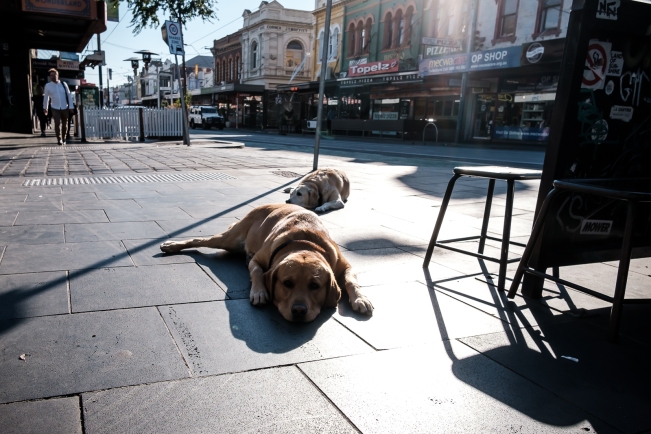A couple of weeks ago I was fortunate enough to receive a loan copy of the brand new Fujifilm XF16mmF2.8 lens from Fujifilm Australia. You may already be aware of this as at the time I published a little preview blog about my first impressions of the product itself. In short, I highlighted that it is an incredibly solid build quality with the same style as the other smaller Fujifilm lenses. The ‘Fujicron” F2 lenses in the XF23mmF2, XF35mmF2 and the XF50mmF2. Light, compact and weather and dust sealed. And at around $700, almost half the price of the original XF16mmF1.4, it brings this style of lens in the reach of many more Fujifilm shooters. That is all lovely and given my past praise for this lineup of smaller primes, not surprising. But how does it actually perform?

I put this lens through its paces attached to the Fujifilm X-T3. I already own and primarily use the Fujifilm XF23mmF2 and the XF50mmF2, so I am more than comfortable with the smaller form factor of this lens. What’s more, the total combination of the lens (155gm) and the camera came (539gm with battery) in at 694gm. Given that I prefer to shoot handheld and carry with a hand strap, I have no dramas taking this kit on a decent street walk. What’s more, I could have the XF23mmF2 or the XF50mmF2 in my back pocket. The aperture ring has a great responsive clicky feel to it, and the aperture markings are bright and obvious. The focus ring has a buttery smooth glide with just the right amount of resistance. The weather sealing ring and mount are of the same quality and precision engineering as any X mount lens. It gives a crisp click when fitted to the camera body.

Let’s talk about autofocus. I have owned or used almost every Fujifilm X Series lens except for a couple of the newer big zoom lenses. Stay tuned for future blogs where I fill those gaps. The Fujifilm XF16mmF1.4, XF23mmF1.4, XF35mmF1.4 and even the XF56mmF1.2 all produce exceptional image quality. They produce sharp, crisp images edge to edge. But, in my opinion, their capacity to achieve fast autofocus was limited. And as you attach these older lenses to newer and newer X System camera bodies, that becomes more obvious. In lower light, the faster aperture is of benefit, but the autofocus will subject hunt slowly. The motors inside the lenses were drawing power from the camera to push and pull larger pieces of glass to achieve focus.


Then along came the F2 lenses. Smaller in size and with faster, newer and more economical motors moving far smaller and lighter pieces of glass. Matched to any Fujifilm X System camera body, these lenses are fast on autofocus – far faster than their older siblings. And with the new Eye Auto Focus on the Fujifilm X-T3, the subject acquisition is fast and lasting. The XF16mmF2.8 news is no different. The autofocus is quick and snappy. I consider the XF23mmF2 lens to have one of the most rapid autofocus responses of any Fujifilm lens. The XF16mmF2.8 is not far away from that same level of performance. This is perfect if you are using this lens in a street setting or any scenario with moving subjects.

Let’s talk about image quality. I took a broad range of shots with various themes and styles in different conditions. Probably not as extensive a variety of shots as some would like in a review but still – I took enough. A caveat that I want to add to any statements about image quality is that it takes two to tango! Yes, the lens plays a critical part in image quality. But so too does the camera body you attach it to. Put a current generation $3,000 glass onto a sloppy older low spec camera body and – well what did you expect would happen? The camera sensor and processor has just as much responsibility in image quality as the lens. Having said that, this little lens puts out fantastic image quality. Images are sharp across the board at slower apertures. And focus details are crisp at faster apertures.

So who is this lens for? That is a question that is often asked about gear. Sometimes it annoys me as lens choice is impacted by so many factors. The simple answer is anyone! Truly. Anyone that is looking for the current generation of technology in a wider prime lens at an affordable price. Remember that the first generation Fujifilm XF16mmF1.4 lens is brilliant, but it is using tech that is over 4 years old. And for fear of sounding like a broken record, there is no point getting the latest and greatest Fujifilm X System body to encourage old tech to behave like new tech. It just won’t happen. But then again, it depends on what you are shooting. People say they need those older lenses for low light shooting as they have a faster aperture. For me, that makes sense if you are happy for all of your event images to have a paper thin focal plane. And again, the low light performance takes two to tango.

This lens is excellent for people that like a more compact system or even kit in their bag. Lighter primes are appealing for people that prefer to shoot primes but don’t feel like carrying more than two due to size and weight. I have shot events with these F2 lenses and had one on the camera and another in my back pocket. No camera bag was banging off my hip or into guests as I make my way around the event. If you are looking for a prime with a punchy focus system attached to your punchy new Fujifilm X System body – then this is an instant win. And so much more affordable. If you are a professional photographer working at high specs for clients, then perhaps go with the older XF16mmF1.4 as it does have overall better image quality and yes a 1.4 aperture. Alternatively, if you were a zoom shooter yet wanted to have a quick and easy wide prime to have in your kit for the odd landscape shot, then you cannot go wrong with the Fujifilm XF16mmF2.8. After all, it is only 155gm in weight. That is actually lighter than the XF2X teleconverter that many big zoom shooters invest in.

As I said, this little cracker of a lens is suited to anyone. Everything about it has appeal to anyone. Size, form, weight, the field of view, weather sealing, autofocus performance, image quality and at a price tag that makes it available to a much broader audience of Fujifilm X System shooters. I have thoroughly enjoyed shooting with this lens and cannot fault it. Will I be buying one? Sadly I have to return the loan unit to Fujifilm Australia. And I want to thank them for the generosity of providing the lens to test and review. At some point I will be picking this lens up to complement my XF23mmF2 and the XF50mmF2. I used the XF16mmF1.4 extensively on my first trip to Tokyo in 2015 and loved the dynamic angle it gave me on the street. I could see myself adopting the same style with this newer model. Happy shooting.


8 Responses to Fujifilm XF16mmF2.8 – Review
Thanks for the review. I find it very useful, but not good for my G.A.S. 😀
I have the old XF14mm and I’ve been wondering if I should get this little one since the day it was announced, but I also have a 23 f1.4 and maybe 16 and 23 are too close. What do you think, should I get one? I’d lose those huge 2mm in the wide end but I’d get more portability, focus speed and WR… Sooo hard haha
LikeLiked by 1 person
It is always a tough decision especially when you already have lenses close together. I feel that despite having a 23mm the 16mm is a lot different field of view. At the wide end, those few mm make a far bigger difference than at the long focal end. The 14mm is a great lens, but old and yes slower tech. I have the 23mmF2 and will buy this new 16mm as soon as I can afford it. Thye give me very different outputs and styles. Hope that helps. Cheers. Greg
LikeLike
Greg, how do you fit a Fujicron into a back pocket? Do you have really larger pockets and pants?
LikeLiked by 1 person
Just wearing jeans. Not skin tight jeans obviously!
LikeLike
I’m too old for skinny jean. But maybe my backside is too big. Those lenses won’t fit in my back pocket.
LikeLiked by 1 person
Regarding the 23mm F2 – I’ve noticed a softer focus when the lens is opened up to F2. Can you confirm this – and if so, if you had to pick between the two for a prime lens, would you take the 16mm or 23mm? Thanks!
LikeLiked by 1 person
Great questions. I have not noticed that much softness with my style of photography. All I know is that the centre is super sharp when capturing a subject with an appropraite faster shutter speed, etc. As for the 16mm v the 23mm – I would go for the 23mm for a general purpose lens. You can use this focal distance in most situations if you have to – which is why they use the 23mm for the Fujifilm X100 series. Good for street. Good for family photography. Wide enough to capture some landscape. Can get in close for portrait without too much distortion. The 16mm is a little more limiting. Great for landscape, architecure or even for street if you like to have a bit more background story to your images. Hope that helps a little. G
LikeLike
[…] final lens that I own is the Fujifilm XF16mmF2.8 WR compact wide prime. It’s a gorgeous little lens and so incredibly lightweight at just 184.5 […]
LikeLike